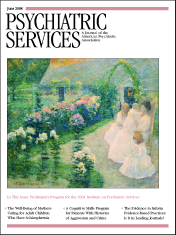Multiple Stakeholder Agreement on Desired Outcomes for Adolescents' Mental Health Services
Abstract
OBJECTIVES: This study identified desired outcomes for adolescent mental health services according to various stakeholders—adolescents, parents, and therapists—and examined agreement across these groups of stakeholders. Potential correlates of agreement, including the youth, family, and treatment characteristics, were also tested. METHODS: Interviews were conducted with 170 adolescents aged 11 to 18 years, their caregiver, and their psychotherapist when the adolescents entered community-based outpatient mental health services. Each participant reported up to three desired outcomes, which were coded into 30 outcome categories across five broad outcome domains. RESULTS: Although the most commonly reported desired outcome across all three stakeholder groups was to reduce anger and aggression, relatively poor agreement existed within the adolescent-parent-therapist triads on desired outcomes for individual youths. Almost two-thirds of the triads did not agree on even one of the desired outcomes for the adolescent's treatment, and most kappa statistics reflected poor agreement. Youths and therapists were each more likely than parents to report desired outcomes that were related to the family environment; youths were the least likely to report desired outcomes that were related to youth symptom reduction. Although many potential correlates of agreement were tested, only two variables were significantly associated with the likelihood that the individual triads would agree on treatment goals: youth anxiety disorder was associated with significantly greater agreement, whereas therapist cognitive-behavioral orientation was associated with significantly poorer agreement. CONCLUSIONS: Consistent with the research on adult mental health services, a lack of consensus was found among key stakeholders on desired outcome priorities for adolescent services. This lack of consensus may limit engagement in treatment and the effectiveness of care.



